Students in New Sustainability Course Tackle Real-World, Campus Problems
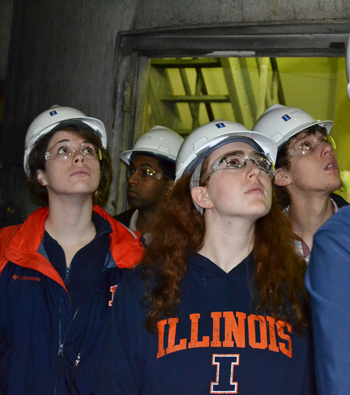
CEE 398 students examine the smoke stacks during a tour of Abbott Power Plant.
December 10, 2013
Ever complained about the poor condition of Illinois' interstates? Ever worried about our ever-burgeoning landfills full of garbage? Ever complained about the pot holes in campus streets, or been embarrassed that visitors' first impression of campus is a whiff of the South Farms? The 14 Civil and Environmental Engineering students who took CEE 398 PBL, a brand new sustainability course in Fall 2013, got the chance to do something about some of these issues.
Civil engineers by trade, co-creators/instructors Jeffery Roesler and Jack Dempsey both embrace sustainability; thus, it's one of the core focuses of CEE 398 PBL. The PBL in the course rubric stands for Project-Based Learning, and the two made sure students' projects tackled plenty of real-world problems—most of them on campus.
During the course, students looked at six case studies and collaborated on four main projects, most of which addressed campus problems like storm-water drainoff, providing power in an ecologically friendly way, and dealing with campus waste. The four main projects included:
- Business Instructional Facility Energy Efficiency Analysis
- Feasibility Study of Bio-Binder
- Waste to Energy: Catalytic Gasification vs. Anaerobic Digestion
- Raw Water Usage on Campus
The pièce de résistance of the course was the December 9th Sustainability Poster Session and Reception, where students presented the results of their projects.
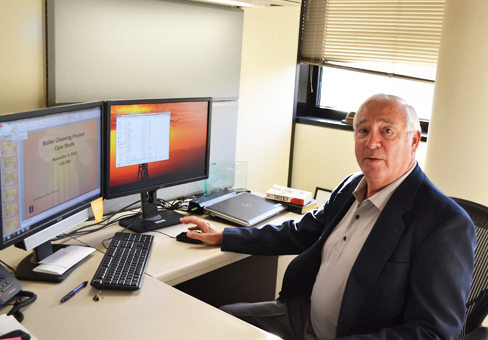
Jack Dempsey, co-creator and instructor of the CEE 398 PBL course.
For instructor Jack Dempsey, CEE 398 PBL will enable him to check off one item from his "Bucket List"—things he has dreamed of doing at Illinois, but couldn't find the time. A LEED-certified engineer with a Ph. D. in Civil Engineering, Dempsey was head of Facilities and Services for the last 14 years and too busy taking care of the university's $3 billion-worth of facilities. But now that he's stepped down from that role, he's trying to make some of those dreams come true.
Of CEE 398, he says: "I've been thinking about this for a couple of years. It fits into something larger." That "something larger" is his dream to see University facilities, and the campus itself, become more than just places where learning occurs, but to serve as the subject matter for learning opportunities:
"You take that investment," he says, "and you give the faculty and students the opportunity to use it in a way that increases research and teaching."
In a serendipitous coincidence, Jeffery Roesler, coming from a completely different campus trajectory as a Professor in Civil and Environmental Engineering, simultaneously had the same idea for a new sustainability course connecting campus problems with students and faculty.
So how did these two kindred spirits get hooked up? Dempsey reports, 'Yea, it was like serendipity. I was out looking, and I talked to Barbara Minsker, and Barbara said, 'Gee, there's this other guy, Jeff…' So the two ended up collaborating.
Dempsey, who for years manned the office where "the buck stops," has enjoyed coming at campus problems from the academic perspective for a change. "I've got to tell you, this has been a learning experience for me, to be a practitioner for all these years, and now we're melding the academic side and the practitioner side, and we're both learning stuff."

Instructor Jeff Roesler (left), a CEE 398 student, and Abbott Power Plant Engineer Mike Larson during a site visit to the power plant.
The course was designed to help younger students think like engineers to solve problems. Roesler's goal for CEE 398 was "to have students identify themselves as engineers when they're younger, when they're freshmen and sophomores, so they know what engineers do and what they think about. And then it helps them connect things that they see going on around them and how they can help solve those."
Do younger students know enough to begin to address problems? "They don't have to know everything about engineering at that point," explains Roesler.
According to Dempsey, the course was also designed to help students decide what area of civil engineering they want to concentrate on:
"The idea being: 'Look at what it is civil engineers do, so when you make a decision for your junior and senior year, if you want to be in environmental, structural, soils…I mean, we have all these different fields in civil. Now that you've seen all of the themes, you take your junior or senior year and focus on the one that interests you."
Dempsey also acknowledges that students could discover that civil engineering isn't for them. "Or you could look at it and say, 'This really isn't what I want to do,' which is even more valuable."
So exactly what do Civil Engineers do? The typical response of Joe Q. Public on the street might be: "Build bridges or buildings."
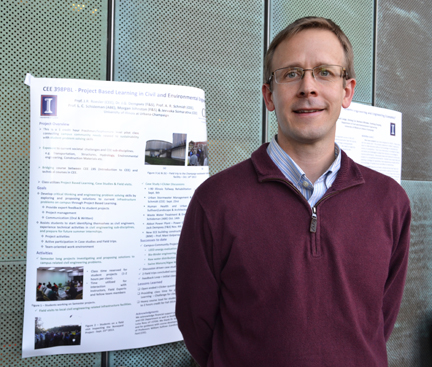
Professor Jeff Roesler, one of the instructors of CEE 398 PBL, during the SIIP poster presentation.
"Civil engineers think about what's good for society," Roesler elaborates, including things they consider when building. "There's always a price tag associated with it, but there's also a societal value of how we're going to make decisions. We look at the environment also. So, societal values, environment, and cost are a big issue."
His definition of sustainability involves dollars and cents: "Anything that involves sustainability usually also involves saving money."
Interested in sustainability since the '70's, Dempsey agrees. "In Civil, you're really driven by the cost. You're doing municipal work, or you're building a building…Cost is an important element. So any time you can reduce either the initial or life-cycle cost, it is a positive thing."
CEE 398's projects and case studies taught students about sustainability via hands-on opportunities to solve problems. One involved the rehabilitation of the I-90 tollway in Chicago.
"I-90 in Chicago—there's a big problem," says Roesler, whose work involves recycling pavements. "It's deteriorating. 'What are we going to do with it?'"
He goes on to explain how they taught the students to problem solve—just like real engineers:
"So you step the student through what an engineer would do, and then we integrate, 'Well, should we recycle the materials?' And then they say, 'Yea.' And then we ask, 'Well, how much?' And then they say, 'Oh, we have to test that, and figure that out.' And then they start seeing the complexity involved in making all of these decisions."
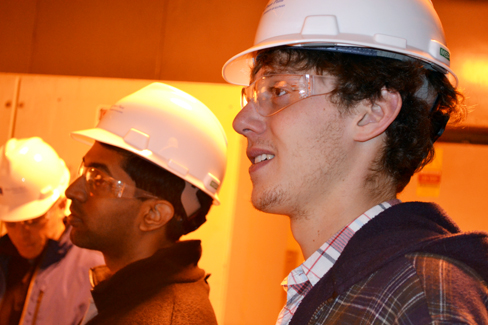
Two Civil & Environmental Engineering students during a site visit to the university's power plant.
Since taking a problem our society faces and turning it into a solution is also near and dear to Dempsey's heart, he heartily approves of Roesler's solution regarding recycling road materials: "You tear them up. You don't want to go throw them in a pile somewhere. Those materials can be reused; that means you don't have to go buy new materials, haul them to that job."
Dempsey has also been watching the project revisiting the LEED certification of the Business Instructional Facility (BIF) with keen interest. "That was kind of a cool one," is his somewhat understated assessment of the project. Because it turns out that Dempsey was instrumental in the initial LEED certification of BIF five years ago. However, it's possible that the building could have lost energy efficiency over the years. "Well, it'll be interesting," he says. "It very well could."
So Dempsey has been especially anxious to learn the results of this project: "That's the beauty of what they're doing. This is one of those opportunities …You build the building, and you walk away from it…"
BIF's certification had recently been recommissioned, just to make sure all the systems are working, so students on the project had access to these data. One item Dempsey has been particularly curious about is the solar array on top of the auditorium—one of the first in the country, and definitely the first one on campus—because the equipment, intended to provide a certain amount of electricity, could degrade more quickly than expected.
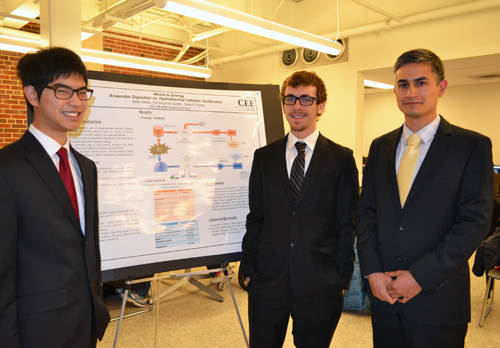
The team of CEE 398 students who worked on the Anerobic Digestion project.
Another project that makes a problem the solution is anerobic digestion: "We're not going to change the way cows are…or pigs," Dempsey admits. "But we're going from where it was a problem to where it is a solution. And that's the cool thing. There are professors all over this campus doing work related to these kinds of things, and this course is our first chance to connect with some of them."
For example, Lance Schideman, who is involved with the course, researches hydrothermal liquefaction, a process which turns algae into oil. And, according to Dempsey, between hydrothermal liquefaction and anaerobic digestion, we could be just a hop, skip, and a jump away from turning garbage into fuel that cars could run on. Instead of turning animal waste into gas to run a turbine, it could be turned into gas to run automobiles.
"This sounds suspiciously like Doc Brown's Flux Capacitor in Back to the Future," gloats this reporter, who, like many science fiction aficionados, boasts that, in hindsight, scifi is often more science than fiction. (For those under the age of 30, the Flux Capacitor turned common, household garbage into fuel.)
"Oh, we're going to do it," Dempsey concedes. "It's just a matter of time." While students may not necessarily come up with the solution in a semester, he hopes future students will continue the project…possibly as their life's work.
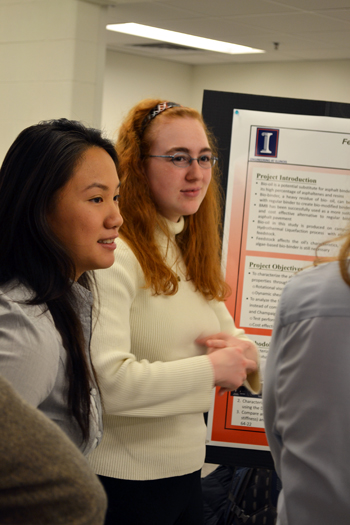
CEE 398 students Ferisca Putri and Kathleen Hawkins explain their project to visitors to the course's final poster session.
Regarding thinking like an engineer, one real-world issue students grappled with was working in teams. Writing a team charter detailing how they were going to work together was evidently an issue for the Lone-Ranger types.
"But all of a sudden, it's like, 'Oh, gee, I'm in this consulting company (it's only 4 students)," Dempsey elaborates. 'How're we going to work together? Are we going to meet? Are we going to use email?' But whatever they do, they've got to work with that group. And if they're Civil's, if they're building that bridge…"
Another real-world skill students learned was accomplishing a project in a given time-frame: in this case, one semester. "Some of the teams, they wanted to save the world," reports Dempsey.
"To get them to write the proposals narrow enough," he continues, "we had to keep reminding them, 'You only have 16 weeks.' 'But now, you only have 14 weeks!...Focus on what you can finish!'"
"So, in the end, they've had to figure out how to work together, give us a proposal, analyze the data, come to some conclusions, and make recommendations…all that in a semester. That's what they're going to have to do in real life."
According to Roesler, one aspect of the course that students particularly enjoyed was the field trips related to the problems being studied in the case studies or projects, such as to BIF, Boneyard Creek, and Abbott Power Plant, for example. During these visits, students were exposed to real engineers in the trenches. "I think students really value a field trip where there's an engineer telling the story," he admits.

Jack Dempsey and Brian Lai during the course's final poster session.
Dempsey also appreciated the students' excitement: "So it's been kind of fascinating to watch them. We took them to the sewage treatment plant...We couldn't get them to go home. Class is over at 6:50...they're still there."
Dempsey sums up the course in a nutshell: "So they get to see the different kinds of engineering; they get to work together; they get to decide whether or not that's really what they want to do; and then they're meeting people outside who do this stuff."
Story and photographs by Elizabeth Innes, Communications Specialist, I-STEM Education Initiative.
More: Civil Engineering, Environmental Engineering, Undergrad Education Reform, 2013
For more on CEE 398 PBL, see the I-STEM article: SIIP: Reforming Undergraduate Engineering to Engage Students
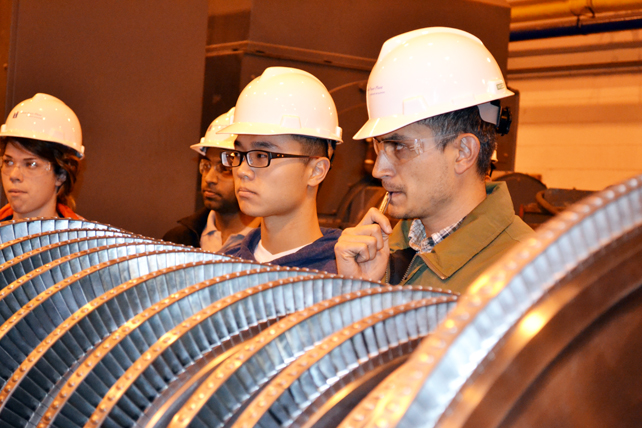
CEE 398 students during a tour of Abbott Power Plant.













.jpg)
















